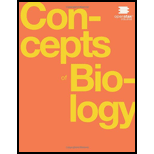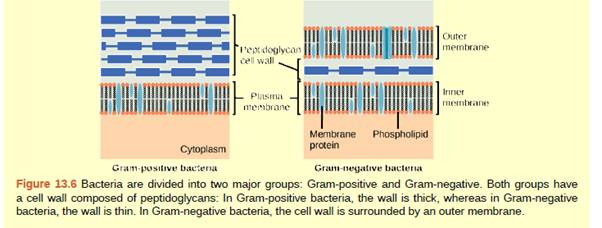
Concept explainers
Figure 13.6 Which of the following statements is true?
a. Gram-positive bacteria have a single cell wall formed from peptidoglycan.
b. Gram-positive bacteria have an outer membrane.
c. The cell wall of Gram-negative bacteria is thick, and the cell wall of Gram-positive bacteria is thin.
d. Gram-negative bacteria have a cell wall made of peptidoglycan, while Gram-positive bacteria have a cell wall made of phospholipids.

Introduction:
The gram stain test is used to differentiate between the gram-positive bacteria and gram-negative bacteria. The gram-positive bacteria retain the crystal violet stain of the gram stain test. While, the gram-negative bacteria, do not retain the crystal violet stain when discoloring agent is applied to it.
Answer to Problem 1ACQ
Correct answer:
Among the answers given, the correct answer is option (a) the cell wall of gram-positive bacteria us formed only of peptidoglycan.
Explanation of Solution
Explanation/justification for the correct answer:
Option (a) is the cell wall of gram-positive bacteria is formed only of peptidoglycan. The cell wall of gram-positive bacteria is thick as it contains many layers of peptidoglycan. Whereas, the cell wall of gram-negative bacteria is thin layered and is composed of peptidoglycan and other structures. Hence, this option is correct.
Explanation for incorrect answer:
Option (b) is gram-positive bacteria contains an outer membrane. The cell wall of gram-negative bacteria is surrounded by an outer membrane, while there is no outer membrane in gram-positive bacteria. Hence, this option is incorrect.
Option (c) is the cell wall of gram-negative bacteria is thick and that of gram-positive bacteria is thin. Many layers of peptidoglycan make the cell wall of gram-positive bacteria thick, while a single layer of peptidoglycan in gram-negative bacteria makes the cell wall thin. Hence, this option is incorrect.
Option (d) is the cell wall of gram-negative bacteria is made of peptidoglycan and that of gram-positive bacteria is made of phospholipids. The cell wall of gram-positive bacteria does not contain phospholipids. It is made up only of peptidoglycan. On the other hand, the cell wall of gram-negative bacteria contains other structures along with peptidoglycan. Hence, this option is incorrect.
The correct statement is that gram positive bacteria contains only of peptidoglycan. Hence, option (a) is correct.
Want to see more full solutions like this?
Chapter 13 Solutions
Concepts of Biology
Additional Science Textbook Solutions
College Physics
Human Biology: Concepts and Current Issues (8th Edition)
Biology: Life on Earth
Becker's World of the Cell (9th Edition)
Microbiology with Diseases by Body System (5th Edition)
Study Guide for Campbell Biology
- Which of the following is NOT true about gram-positive and gram-negative bacteria? a. None of the other four answers (all are true) b. Gram-negatives have thicker cell walls than gram-positives c. Cell walls are made of peptidoglycan in both gram-positives and gram-negatives d. Peptidoglycan has a carbohydrate (NAG/NAM) backbone cross-linked by chains of amino acids e. Gram-negatives have an outer membrane outside of the cell wall, composed of lipopolysaccharidearrow_forwardGram-positive (+) and gram-negative (-) bacteria are characterized by differences in a. the cell wall: gram+ have peptidoglycan, gram– have pseudopeptidoglycan. b. the plasma membrane: gram+ have ester-linked lipids, gram–have ether-linked lipids. c. the cell wall: gram+ have a thick layer of peptidoglycan and gram– have an outer membrane. d. chromosomal structure: gram+ have circular chromosomes, gram– have linear chromosomes.arrow_forwardCan you answer all the parts to this question please A. What is the difference in peptidoglycans in gram negative vs gram positive cells/ B. Why does Gram stain not bind to gram negative bacteria?arrow_forward
- Select a statement that is not correct about bacterial fimbriae? A. they protect the cell from dehydration B. they are called attachment pili to distinguish them from the pili used to transfer DNA during conjugation C. they are used to attach the cell to its substrate or to other prokaryote D. they are hair-like projections that aid in attachment.arrow_forwardWhich of the following is TRUE regarding Gram negative bacteria? a- Their cell wall is composed of a large proportion of sugars b- Their cell wall does not absorb the Gram stain and turns pink c- Their cell wall is composed of a small proportion of peptidoglycan d- Two of the above statements are truearrow_forwardUse the following diagram to answers the questions. A. Is this cell Gram + or Gram -? Provide 2 pieces of evidence to support your choice. B. If you are infected by this bacterium can the antibiotic be effective in killing it. Explain. C. NAME and label the structures in the diagram that could be involved in conjugation? Why conjugation is an important process for the bacteriaarrow_forward
- How do Gram-negative bacteria differ from Gram-positivebacteria?a. They are not pathogenic.b. Their peptidoglycan cell wall is thinner.c. Gram-negative bacteria cannot be Gram stained.d. They possess a single plasma membrane.e. Gram-negative bacteria do not photosynthesize.arrow_forwardPlease explain in simple worlds What is peptidoglycan that are found in gram cell walls?arrow_forwardSelect a statement that is not true about bacteria A. Some bacteria cause human disease B. Some bacteria are autotrophs C. Bacteria can be found within rocks kilometers below the Earth’s surface D. All organisms with cells containing a membrane-enclosed nucleus and organelles are eukaryotes, whereas all organisms with cells lacking a membrane-enclosed nucleus and organelles are bacteriaarrow_forward
- Which of the following are TRUE of yeast? Yeast are Gram-positive cells.Yeast are Gram-positive cells. Yeast are Gram-negative cells.Yeast are Gram-negative cells. Yeast are neither Gram-positive or Gram-negative cells.Yeast are neither Gram-positive or Gram-negative cells. Yeast have a peptidoglycan cell wall.Yeast have a peptidoglycan cell wall. Yeast do not have a cell wall.arrow_forwardWhich of the following is NOT a true statement about bacterial structure and function? A. Bacteria can have membrane-enclosed organelles such as mitochondria or chloroplasts B. Bacteria have a single circular chromosome made of double-stranded DNA C. Bacterial cell walls are made of a substance called peptidoglycan D. Bacterial flagella rotate to propel the cell E. Some bacteria have a capsule surrounding the cell, made of a sticky polysaccharide or proteinarrow_forwardWhich of the following statements is not true?(A) Archaea and bacteria have different membrane lipids.(B) The cell walls of archaea lack peptidoglycan.(C) Only bacteria have histones associated with DNA.(D) Only some archaea use CO2 to oxidize H2, releasing methanearrow_forward
 Concepts of BiologyBiologyISBN:9781938168116Author:Samantha Fowler, Rebecca Roush, James WisePublisher:OpenStax College
Concepts of BiologyBiologyISBN:9781938168116Author:Samantha Fowler, Rebecca Roush, James WisePublisher:OpenStax College Biology 2eBiologyISBN:9781947172517Author:Matthew Douglas, Jung Choi, Mary Ann ClarkPublisher:OpenStax
Biology 2eBiologyISBN:9781947172517Author:Matthew Douglas, Jung Choi, Mary Ann ClarkPublisher:OpenStax Comprehensive Medical Assisting: Administrative a...NursingISBN:9781305964792Author:Wilburta Q. Lindh, Carol D. Tamparo, Barbara M. Dahl, Julie Morris, Cindy CorreaPublisher:Cengage Learning
Comprehensive Medical Assisting: Administrative a...NursingISBN:9781305964792Author:Wilburta Q. Lindh, Carol D. Tamparo, Barbara M. Dahl, Julie Morris, Cindy CorreaPublisher:Cengage Learning



